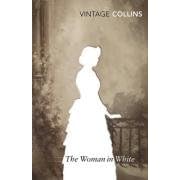 --The blurb--
--The blurb--"The Woman in White famously opens with Walter Hartright's eerie encounter on a moonlit London road. Engaged as a drawing master to the beautiful Laura Fairlie, Walter is drawn into the sinister intrigues of Sir Percival Glyde and his 'charming' friend Count Fosco, who has a taste for white mice, vanilla bonbons and poison. Pursuing questions of identity and insanity along the paths and corridors of English country houses and the madhouse, The Woman in White is the first and most influential of the Victorian genre that combined Gothic horror with psychological realism."
--The review--
Popularity is in a way like a runaway freight train: for whatever reason, a thing becomes popular. People then choose to read, consume or experience it because it is popular, thus making it more popular...and so it goes on. The marginalised, however, rightly or wrongly, in most cases remain so. Wilkie Collins is arguably an author of the latter category: while his novels The Moonstone and The Woman in White are relatively well-known, he and his other works have fallen by the wayside, while his contemporary and colleague, Charles Dickens, jumped aboard said runaway train with aplomb and has not got off since. However, those seeking a slightly off-road challenge will undoubtedly be rewarded with The Woman in White.
Even though there is certainly a little Miss Havisham in Anne Catherick (one of the novel's main personages), Collins is decidedly his own writer and not just a mere Dickens knockoff. While the character of Walter Hartright is clearly meant to seem dashing but only gives a slightly insipid impression, this is more than compensated for by the other characters. Marian provides stability and momentum, with Count Fosco adding the requisite wickedness and Laura being there to be appropriately lovely and simpering. Further to this, Collins combines traditional themes and genres (mystery, identity, madness) in a way that makes the novel really quite unusual. Surprise and suspense await the reader at every turn, and while there are one or two inconsistencies or instances where a little more clarity would be helpful, this on the whole does not impede understanding or enjoyment.
Atmosphere is deftly created and maintained, and the vast country residence shrouded in Victorian fog suitably foreshadows other successful classics, such as Frances Hodgson Burnett's The Secret Garden. Narrative voices are changed well and for good, realistic reasons (with said reasons being revealed either at the time or towards the end of the book, as is fitting). It is perhaps testament to the book's gripping and compulsive nature that readers find themselves fervently wishing for characters to have justice be served, even when at times this seems at its most improbable; thankfully, though, they do, and the book is made all the better for it. Even though we would certainly all get fed up if books constantly presented us with happy endings, here it works well. It is almost astounding that Collins should be so in the shadow of his better-known contemporaries; those who brush him aside are missing out on a cache of fabulous reads.
Other works by Wilkie Collins
Basil (1852)
No Name (1862)
Armadale (1866)
The Moonstone (1868)
Poor Miss Finch (1872)
The Law and the Lady (1875)
The Black Robe (1881)





No comments:
Post a Comment